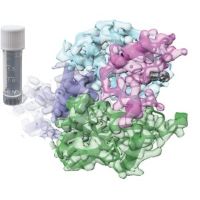Specification
| Description | Recombinant protein from the full-length sequence of Homo sapiens checkpoint with forkhead and ring finger domains (CHFR), transcript variant 1 (NM_001161344). |
| Organism | Homo sapiens (Human) |
| Expression Host | Human Cells |
| Tag Info | His or DYKDDDDK. Please contact us if you need further information or require specific designed tag. |
| Purity | Greater than 90% by SDS-PAGE gel |
| Uniprot ID | Q96EP1 |
| Entry Name | CHFR_HUMAN |
| Gene Names | CHFR RNF196 |
| Alternative Gene Names | RNF196 |
| Alternative Protein Names | E3 ubiquitin-protein ligase CHFR (EC 2.3.2.27) (Checkpoint with forkhead and RING finger domains protein) (RING finger protein 196) (RING-type E3 ubiquitin transferase CHFR) |
| Application | Antigens, Western, ELISA and other in vitro binding or in vivo functional assays, and protein-protein interaction studies; For research & development use only! |
| Buffer | Purified protein formulated in a sterile solution of PBS buffer, pH7.2, without any preservatives |
| Endotoxin | Endotoxin level is < 0.1 ng/µg of protein (<1EU /µg) |
| Length | 664 |
| Molecular Weight(Da) | 73386 |
| Protein Sequence | (The sequence of expressed protein may have some variation from the sequence shown below. Please contact us for the exact sequence.) MERPEEGKQSPPPQPWGRLLRLGAEEGEPHVLLRKREWTIGRRRGCDLSFPSNKLVSGDHCRIVVDEKSGQVTLEDTSTSGTVINKLKVVKKQTCPLQTGDVIYLVYRKNEPEHNVAYLYESLSEKQGMTQESFEANKENVFHGTKDTSGAGAGRGADPRVPPSSPATQVCFEEPQPSTSTSDLFPTASASSTEPSPAGRERSSSCGSGGGGISPKGSGPSVASDEVSSFASALPDRKTASFSSLEPQDQEDLEPVKKKMRGDGDLDLNGQLLVAQPRRNAQTVHEDVRAAAGKPDKMEETLTCIICQDLLHDCVSLQPCMHTFCAACYSGWMERSSLCPTCRCPVERICKNHILNNLVEAYLIQHPDKSRSEEDVQSMDARNKITQDMLQPKVRRSFSDEEGSSEDLLELSDVDSESSDISQPYVVCRQCPEYRRQAAQPPHCPAPEGEPGAPQALGDAPSTSVSLTTAVQDYVCPLQGSHALCTCCFQPMPDRRAEREQDPRVAPQQCAVCLQPFCHLYWGCTRTGCYGCLAPFCELNLGDKCLDGVLNNNSYESDILKNYLATRGLTWKNMLTESLVALQRGVFLLSDYRVTGDTVLCYCCGLRSFRELTYQYRQNIPASELPVAVTSRPDCYWGRNCRTQVKAHHAMKFNHICEQTRFKN |
Background
| Function | FUNCTION: E3 ubiquitin-protein ligase that functions in the antephase checkpoint by actively delaying passage into mitosis in response to microtubule poisons. Acts in early prophase before chromosome condensation, when the centrosome move apart from each other along the periphery of the nucleus. Probably involved in signaling the presence of mitotic stress caused by microtubule poisons by mediating the 'Lys-48'-linked ubiquitination of target proteins, leading to their degradation by the proteasome. Promotes the ubiquitination and subsequent degradation of AURKA and PLK1. Probably acts as a tumor suppressor, possibly by mediating the polyubiquitination of HDAC1, leading to its degradation. May also promote the formation of 'Lys-63'-linked polyubiquitin chains and functions with the specific ubiquitin-conjugating UBC13-MMS2 (UBE2N-UBE2V2) heterodimer. Substrates that are polyubiquitinated at 'Lys-63' are usually not targeted for degradation, but are rather involved in signaling cellular stress. {ECO:0000269|PubMed:10935642, ECO:0000269|PubMed:11807090, ECO:0000269|PubMed:11912157, ECO:0000269|PubMed:14562038, ECO:0000269|PubMed:14694445, ECO:0000269|PubMed:18172500, ECO:0000269|PubMed:19182791}. |
| Pathway | Protein modification; protein ubiquitination. |
| Protein Families | CHFR family |
| Tissue Specificity |
QC Data
| Note | Please contact us for QC Data |
| Product Image (Reference Only) |  |

